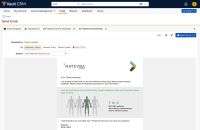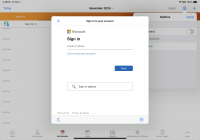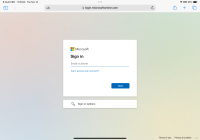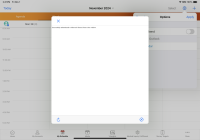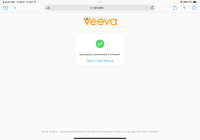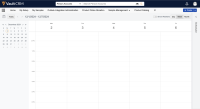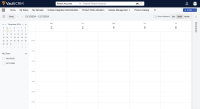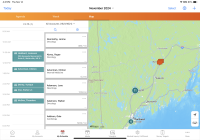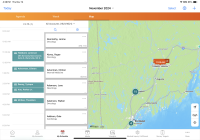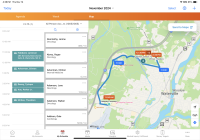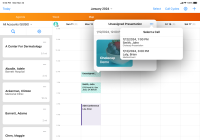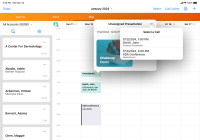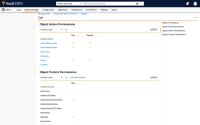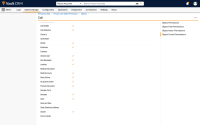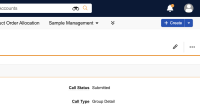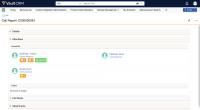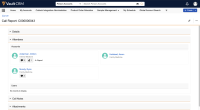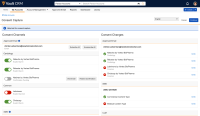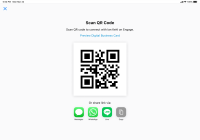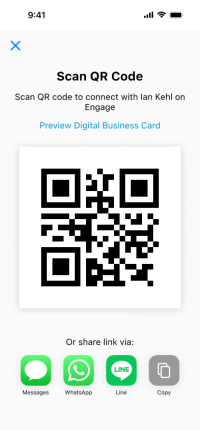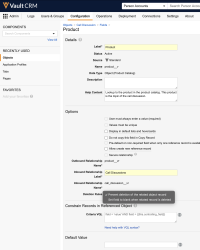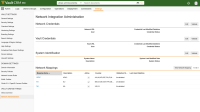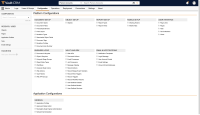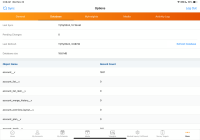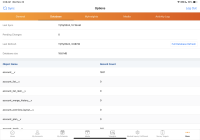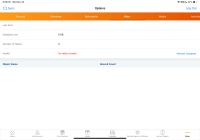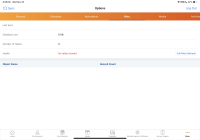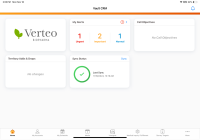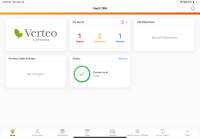What's New in 24R3.0
Our release notes offer brief, high-level descriptions of enhancements and new features.
New Fields and New Objects are also included.
Announcements
Renaming of Vault CRM MyInsights to Vault CRM X-Pages
Vault CRM MyInsights is being renamed to Vault CRM X-Pages. This change emphasizes that X-Pages is a platform within Vault CRM designed to help tailor custom user experiences. The new name reflects the platform's evolution and more accurately represents its expanded capabilities in enhancing user experience, extensibility, and cross-platform functionality.
While the name has changed to X-Pages, the technology and features remain the same. Vault CRM X-Pages continues to offer an open, modular, and flexible design, allowing for customization of your CRM experience. It facilitates quicker deployment of brand-specific field insights in one place, helping your team focus on essential tasks and make data-driven decisions with a customized user interface.
Supporting the HCO Kernel of the CDA
The 24R3.0 release supports the HCO kernel of the CDA. Data model updates include adding new fields to the Account object. See Veeva CDA for more information. See Data Model Updates for the Common Data Architecture for Life Sciences for a list of data model changes.
Features
The 24R3.0 release includes features from the following minor releases:
Account Management
Color-Coding Accounts in the Account Hierarchy
Different types of accounts can be color coded in the hierarchy for easy identification. Color can also be used to indicate other account attributes, for example, object type, for quick identification.
Dynamic Attributes for Accounts
Dynamic attributes enable business admin users to define custom fields for collecting business information, without needing IT knowledge or resources. A dynamic attribute is a special type of field that displays on the account details screen and can be created by business admin users without modifying the account object. Business admin users use dynamic attributes to request an end user to collect information about an account for an upcoming business need, for example, a new product launch, campaign or other business initiative. Enabling business admin users to create dynamic attributes removes the burden from the IT team.
Managing Public and Shared Views in My Accounts
Business admin users can create public views that are visible to all users, or share views with specific user profiles. Only business admin users have access to edit these views. End users can create and edit private views, depending on configuration.
Export My Accounts Lists or Views to CSV or Excel
Users can export all data from a My Account list or view to an Excel or CSV file. This allows users to reference account data when they are away from their device.
To help users better understand their accounts’ networks, Global Account Browse enables mobile device users to view out-of-territory accounts in Sphere of Influence or Account Hierarchy.
Account hierarchies enable users to view, understand, and manage account relationships within an organization’s structure. Account hierarchies display all types of business accounts (IDNs, hospitals, clinics, etc.) and the HCPs associated with those accounts in a chart-like, visual format.
Account Plans
Calculating Account Plan Progress Using the Account Plan Hierarchy
Key Account Managers (KAMs) can monitor progress of an account plan so they can understand where to invest time and resources and keep the plan on track.
Product plans outline the strategies and tactics for individual products or brands. They serve as a roadmap for guiding sales teams and ensuring alignment between brand teams and field reps.
Action items are the steps in the plan that team members execute to move the plan toward completion. These action items are defined based on plan goals.
Working with Multiple SWOT and Goal Records
Users working with account plans can create and view multiple SWOT (Strengths, Weaknesses, Opportunities, and Threats) analysis and goal records for account plans. This allows multiple teams to easily contribute to a single account plan for an account and also provides flexibility for each team to have their own SWOT analysis and goals records. These records can also be used to differentiate SWOTs and goals by product, compound, or therapeutic area, based on the products associated with the account.
When users select the View Hierarchy action for an account plan, a view of the account hierarchy for the account displays. This allows users to see the relationships within the account, and access account plan details for account plan stakeholders.
Approved Notes
Approved Notes helps ensure compliance and productivity in Vault CRM by enabling customers to monitor and review free-text fields, for example pre-call and post-call notes.
Call Objectives
Setting Prerequisite Call Objectives
To structure Account Plan goals and major action items, Key Account Managers can set Prerequisite Call Objectives. Prerequisite Call Objectives must be completed before any other Call Objectives in the Account Plan can be executed. Because Account Plans are often executed by a team of end users, designating Prerequisite Call Objectives helps coordinate progress towards larger Account Plan goals across multiple team members.
Call Planning
Color-Coding Planned Calls in My Schedule
To customize and organize their calendars, users can change the sidebar color on planned call entries from the default teal color to any one of 25 predefined colors.
To help users efficiently plan call routes and navigate to scheduled activities, calls, Events Management events, and medical events are plotted along a daily route in Map View. Users can also view nearby accounts and schedule calls from Map View.
To collaborate on call planning and scheduling, users can display another user's calendar activities with their own calendar activities in My Schedule.
Viewing Users' Calendars with Manager View
From My Schedule, managers can review scheduled activities for reports in territories one or more levels below their territory, based on territory hierarchy. This enables managers to easily identify potential conflicts or overlaps in reports’ schedules, and review reports’ workloads for more informed decisions when assigning tasks.
Displaying Events Management Events in My Schedule on iPad
To avoid scheduling conflicts, iPad users can view Events Management events in My Schedule if they are the event owner, or a user or group Event Team Member.
Call Reporting
Selecting Account Plans from Call Reports
To associate an account plan with a call, users can select active account plans from the account plan picklist on the call report. Account plans are available for selection on the call report if there is an active account plan for the primary account on the call, or the account plan contains an account tactic. This enables users to track call activities related to account plans.
Using Action Items on the Call Report
Action items on the call report help users streamline account planning and maximize visit impact by providing a clear overview of tasks and enabling on-the-spot completion. This functionality provides a flexible way to manage tasks for account plans and offers a less-formal alternative to Call Objectives when defining to-do lists for Key Account Managers (KAM) and account plan team members.
Associating Product Strategies and Tactics with Product Discussions
Individual product strategies and tactics can be associated to a product discussion. This enables users to tie product strategies and product tactics to specific discussions with HCPs, for greater specificity in reporting call discussions.
Associating Account Tactics with Product Discussions
Associating account tactics with product discussions enables users to identify how product discussions contribute to, and are based on, specific account plans. This allows for increased specificity in call reporting and in tracking of call activities related to account plans.
Displaying X-Pages Content on the Call Report
The X-Pages widget on the call report displays relevant content that enables users to easily view key information for call reporting without leaving the call report. Content developers can create a custom X-Page for the call report to display e call history for an account, sales data for a product, a summary of the steps to take on the call, or other account data to inform the user’s next visit with an HCP.
Capturing Signatures for Calls Without Samples
To ensure call reports are accurately recorded, users can capture signatures for calls without samples, also known as call acknowledgment. Some organizations require users to capture HCP signatures to confirm a call took place, even though samples and details are not recorded. Similarly, users may be required to collect an HCP signature on detail-only calls to confirm that the product detail information is accurate.
Stamping Suggestion Title and Reason on the Call Report
To help users plan and prepare for calls, the suggestion title and reason display on call reports created from Suggestions and are stamped on the call report record. Business admin users and managers use suggestions to recommend users take certain actions—for example, suggesting users schedule a call with a specific HCP.
Hiding the Submit Button Online
To prevent duplicate call submission and other data issues, the Submit button can be removed entirely from the call report on the Browser platform, while still displaying on call reports on mobile devices. This ensures users can only submit a call from mobile devices, which helps to avoid sync errors, duplicate submissions, or submission of calls that do not have the most up to date information.
By default, submitted calls are locked to preserve data integrity and prevent inadvertent or unauthorized changes. To delete calls or to enable users to edit submitted call information, individual calls can be unlocked by users with the appropriate permissions, typically business admin users.
Capturing Unique Information on Group Call Attendees on Browser
Unique activities on group calls enable users to capture specific information for each HCP selected as an attendee on a group call. This enables users to more accurately record and report field activities, and to record sampling to HCPs with differing sample statuses on the same group call.
Customizing the Attendees Section on Browser
In addition to configuring the functionality and layout of the call report, business admin users can configure the behavior of the attendees section through section attributes. The Attendees Optional and Suppresses Sample Recipient section attributes are now available for the attendees section of the call report on the Browser platform.
Displaying Key Messages by Category on CRM Desktop (Windows)
Key Messages categories are available for the high performance call report on CRM Desktop (Windows). For organizations where users are expected to record Key Messages from certain categories during calls, displaying Key Messages by category can make it easier for the user to see which categories they have covered during the call, and which they have not.
Maintaining Separate Call and Signature Datetimes on iPad and iPhone
When a user accepts a signature on an mobile device, the original call date or datetime is overwritten with the signature datetime by default. However, the call report can be configured to maintain the original call date or datetime, as well as a separate signature datetime.
Call Sampling
The following features are now available on Browser for promotional items, reprints, and custom items:
Campaign Manager
Campaign Manager streamlines the planning, execution, and measurement of promotional efforts targeting HCPs. Through orchestrated campaigns, marketing users in Vault CRM work side by side with field users, ensuring content is consistently applied and reused.
CLM
Viewing and Downloading Media Files for Key Messages
Content admin users can view and download a presentation’s associated media files, including shared resources, on the View All Media page. This makes it more convenient for users to troubleshoot presentations.
Integrating Approved Email with CLM on CRM Desktop (Windows)
Content creators can reference pre-defined Approved Email templates and fragments to allow CRM Desktop (Windows)users to send specific emails and content from a CLM slide to HCPs viewing the CLM content.
Engage
Scheduling and Starting an Engage Meeting on Browser
Meeting hosts can schedule and start Engage meetings against person account calls, classic group calls, or unique activity group calls directly from the call report, improving workflow efficiency. When an Engage meeting is scheduled, the call automatically saves, preventing data loss.
Joining an Engage Meeting on Browser via Zoom®
Engage hosts on Browser can offer attendees the option of joining an Engage meeting via the Zoom® application. This provides another option for HCPs to join virtually, maintaining the compliant hosting capabilities of an Engage meeting while also providing the attendee the choice of joining the meeting via their preferred service.
Sharing Digital Business Cards from the Home Page
The Share Digital Business Card (DBC) component on the home page allows CRM users to send their DBC to HCPs. HCPs can view the DBC and connect with the CRM user if they are signed into Engage. CRM users must have DBCs enabled, but do not need to have Chat or Ping enabled.
Adding Digital Business Cards to Apple Wallet on iPhone
End users on iPhone can add the QR Codes® for their digital business cards to the Apple Wallet. This makes it faster and more convenient for end users to share their digital business cards using their phones outside of CRM.
Displaying the Engage Profile Indicator on Accounts
The Engage profile indicator is a visual cue within Vault CRM to indicate an account, typically an HCP, is linked to an active Engage profile. End users can directly interact with HCPs with linked profiles by initiating chats or other forms of communication. HCPs who have signed up for an Engage account maintain profiles containing their personal information, facilitating seamless and efficient engagement within Vault CRM. To display the Engage profile indicator on accounts, business admin users must sync Engage profile data to CRM using the Engage Connect Profile Sync.
Using Restricted Phrase Rules for Messaging
Restricted phrase rules in Engage chat is compliance-focused functionality in Vault CRM allowing business admin users to prevent end users from sending chat messages containing specific words or phrases. This functionality allows customers to adhere to industry regulations and internal policies. By defining restricted phrase rules, business admin users can effectively limit the use of prohibited language within chat conversations, reducing the risk of compliance violations and protecting the company’s reputation.
Importing Engage Connect Chat Logs into CRM as Call Records
Business admin users can define which types of Engage chat messages to import into CRM as call2__v records to track specific interactions between end users and HCPs. These records contain chat message data and automatically associate with the appropriate accounts and users. For example, if a customer wants all sample requests from HCPs to be tracked as calls in CRM, the business admin user can import only sample request chat messages as call2__v records.
Importing Engage Connect Chat Logs into CRM as Chat Messages
Business admin users can configure Vault CRM to import chat messages from the Engage Connect database as chat_message__v records. These records contain chat message data and automatically associate with the appropriate account and user. The data can be utilized within CRM to help analyze productivity and monitor for compliance purposes with Approved Notes.
Presenting CLM Content Remotely
Presenting CLM content remotely allows HCPs to view CLM content on their own devices during calls without being in a meeting. Details about the session, including the link, are shared with the HCPs using social messaging apps, verbally, or with a QR Code®. Selecting the link allows the HCP to view the CLM content in their browser without installing an app.
Sharing CLM Content via Web Link
End users can use social messaging apps to share links for CLM content published in PromoMats/MedComms, including auto-published content, binders and slides, custom presentations, and websites. Content accessed from a web link displays in the HCP Content Player. Any action the recipient takes on the link is tracked, allowing content admin users to analyze engagement with specific presentations to improve CLM content.
Managing Display Names for CLM Presentations and ISI and PI Documents
Content creators can define display names for each presentation in PromoMats/MedComms, which display in web link previews and in the HCP Content Player. This ensures the appropriate names display to HCPs when viewing content from a web link.
Content admin users can configure processes or workflows to automatically expire web links after a certain amount of time after the links are sent for compliance purposes.s
Defining SMS and WhatsApp Phone Numbers
Content admin users can define the SMS and WhatsApp phone numbers for an account. This automatically populates the recipient phone number when users send links to the account using Messages and WhatsApp.
Using Message Templates When Sharing Web Links
End users can select message templates to send approved messages to HCPs with web links, allowing customers to control the messaging for users. Message templates are available when sharing web links for presentations and websites.
The HCP Content Player is a dedicated browser experience enabling HCPs to view content sent to them from Vault CRM. Engagement with content viewed in the HCP Content Player is tracked and saved in Vault CRM, enabling business admin users to report and audit on activity of sent content.
Content creator users in PromoMats/MedComms can control whether a download button displays in the HCP Content Player for an auto-published CLM presentation. This allows HCPs to download content and view it without an internet connection or save a copy for reference.
Engage HCP
Sharing Digital Business Cards
HCPs can share the link to a CRM user’s digital business card with other HCPs, providing easy access to CRM users’ contact information and encouraging connections with CRM users.
Events Management
Creating Event Approvals Using Object Workflows
Business admin users can leverage Vault's Object Workflow functionality to create custom approval workflows that dynamically update based on specific event attributes, for example, estimated attendance size. By defining these criteria, you can ensure each event follows the appropriate approval process, streamlining operations and maintaining compliance.
Using Approved Email for Events Management
Events Management users can compose and send Approved Emails from their event to communicate with attendees or speakers, for example, to invite them to an event or to provide follow-up material after the event ends.
Hosting a Virtual Event using Engage
Event organizers can host virtual events using Engage. This enables event organizers to plan and schedule virtual events just as they would in-person events, enabling attendees to join the meeting using HCP Attendee apps.
Associating an Account with an Event
Events Management end users can host events with business accounts, for example, a hospital. End users can select a specific account and address to associate with their event, which simplifies the event planning process by filtering the list of available attendees associated with the business account.
Recording a Call from an Event
Events Management end users frequently host small-scale events at specific accounts, for example, healthcare organizations. During these events, the end user may have conversations with attendees necessitating a call report. End users can create call reports directly from their events, which automatically records important event details.
General
Adding a Company Logo to the Login Page and Home Page
Business admin users can add their company logo to display on the login page and home page of Vault CRM for iPad and iPhone. This reinforces brand recognition and provides a consistent user experience.
Managing Vault Messages and Veeva Messages
Business admin users can edit Vault Messages and Veeva Messages to customize text in Vault CRM, for example, to update button labels or to provide more context in error messages. Vault Messages and Veeva Messages store text and labels for all Vault CRM configured components, labels, and error messages.
Supporting Field Subtypes in Vault CRM
When creating fields in Vault CRM, business admin users can select field subtypes to ensure certain types of fields display information in a specific format. A field subtype can automatically apply a format mask or a maximum field length to a field, making it quicker and easier for business admin users to create certain types of fields than defining custom format masks. Vault CRM supports the Time, Email, Phone, Link, and Percent field subtypes.
Supporting Required and Read-Only Fields on Layouts
Business admin users can indicate if fields in a layout are required or read-only, ensuring end users populate the appropriate information when saving records. Required fields must be populated to save a record. Read-only fields cannot be edited.
Using Validation Rules on Mobile Devices
Validation rules define specific criteria records must meet before they can be saved. Using validation rules on mobile devices prevents errors when syncing data online and ensures data integrity and consistency across all platforms.
Viewing and Downloading Files Using the Files Tab
End users can use the Files tab in Vault CRM to view and download files. Business admin users manage files and folders as documents and binders in the Vault Library on Browser and can indicate which documents and binders sync to mobile devices. Once synced, end users can sort and search the Files tab in Vault CRM on their mobile devices.
Medical CRM
Medical Translations allows users to view specific data fields, objects, and user interface elements in terms specific to their company or organization. This feature supports global pharmaceutical and life sciences teams by ensuring that the CRM content, especially critical terms and objects relevant to healthcare professionals, is accessible and accurate for their business.
Multichannel Cycle Plans
Creating Multichannel Cycle Plans
MCCP admin users create Multichannel Cycle Plans (MCCP) to provide a structured framework for planning and executing cross-channel campaigns. MCCP are created either through data loading or manual record creation.
Defining Over Reached and Under Reached Thresholds
To help users stay on track in their interactions with target accounts, under reached and over reached thresholds indicate whether their target, channel, and product activities align with the expected attainment based on the cycle's elapsed time. These thresholds are determined by the MCCP goals set by management. By reviewing their progress against under reached and over reached thresholds, users can adjust their interactions with accounts to meet MCCP goals.
MCCP activities can be capped to prevent users from exceeding predetermined limits on the number of product activities, channel activities, and target interactions in a cycle. Once users reach the maximum number of activities for the product, channel, or target, additional activities are not counted towards their attainment. This helps ensure end users focus on high-quality interactions, and prevents overreliance on certain channels or excessive activity for a single product, channel, or target.
To promote collaboration and streamline goal management, MCCP admin users can set goals for entire account teams or territories. Teams include all MCCP users in territories aligned to a target account, regardless of whether the territory is associated with an MCCP.
Supporting Pull-In Fields for MCCP
To aid end users in identifying MCCP targets, making informed decisions about their outreach to accounts, and increasing efficiency when planning activities, target-related pull-in fields can be configured for the Targets tab in My Plan. Pull-in fields display as an additional column for each target.
Locking Multichannel Cycle Plans
To prevent unintended changes and ensure data integrity, MCCP admin users can lock Multichannel Cycle Plans by enabling the locked__v field on mc_cycle_plan__v records. When the plan is locked, end users cannot edit the plan or related records.
By providing a clear and intuitive dashboard for progress and plan details, the MCCP interface enables end users to stay informed about their performance and take action to reach MCCP goals. End users can view summarized information about their MCCP in a simple visual interface that displays overall activity achievement by channel and by product.
Using Detail Group Goals in MCCP
By default, MCCP goals are set at the product level. However, goals may instead be set at the detail group level when Detail Groups are enabled. Setting MCCP goals at the detail group level streamlines the goal-setting process by reducing the number of individual product goals required. This is particularly useful when tracking goals for individual products would be overly granular or time-consuming.
Detailing Priority for MCCP Targets
To ensure end users prioritize the most critical products when detailing products to HCPs, MCCP admin users can define a detailing priority for each product in a cycle plan. When detailing priority is defined, calls are only counted towards the target account’s attainment values if the product detail order on the call report matches the detailing priority set by the MCCP admin user.
Indicating MCCP Goals by Priority in a Single Call Channel
When end users are contractually obligated to detail a product a certain number of times at different priority levels, MCCP admin users can set separate goals and detail priorities for the same product within a single call channel. This functionality enables end users to easily visualize and track progress against priority-specific goals.
Scheduling Calls for MCCP Targets
To streamline call planning, end users can send individual targets to My Schedule or save MCCP target lists as Account Lists for use on a recurring basis. Saving target lists as Account Lists enables users to access the list from all Account Lists entry points, including My Schedule, where end users can reference the list while they schedule calls.
Displaying MCCP Information in My Schedule
For efficient call planning, end users can access MCCP information in My Schedule. Using the display-by functionality in My Schedule, users select predefined MCCP attributes to display under account names in the account panel. Additionally, when an MCCP display-by attribute is selected, users can view detailed plan information from the View Plan Details pop-up on account cards. This reduces the need to reference separate records when scheduling calls, enabling users to save time and focus on planning calls.
To easily utilize MCCP information when planning calls in My Schedule, end users can filter the list of accounts displayed in My Schedule by MCCP attributes.
Order Management
The following features are now available on Browser and CRM Desktop (Windows):
- Mass Add Order Entry Mode
- Creating an Order from a Call
- Order Campaigns
- Delivery Location
- Payers
- Price Books
- Pull-In Fields on Order Lines
- Transfer Orders
- Product Groups for Order Management
- Order Products
- Product Views
- Managing an Order
- Brand Level Pricing Rules
- Discount Pricing Rules
- In-Level Addition Mode
- Order Net Amount Rounding Mode
- Product Group Level Pricing Rules
- Total Discount and Final Net Price Addition Mode
- Free Goods Percentage Pricing Rules
- Free Goods Pricing Rules
- Cross-Product Pricing Rules
- Limit Pricing Rules
- List Price Rules
The following features are now available on Browser:
The following features are now available on CRM Desktop (Windows):
- Direct Quantity Order Entry Mode
- Changing Order Line Column Widths
- Capturing an Order Signature
- Delivery Order Limit Rule Pricing Rules
- Delivery Order Payment Terms
- Delivery Order Quantity Rollup
- Manual Allocation of Free Goods
- Mid-Negotiation Delivery Splitting
- Pull-In Fields on Orders
- Suggested Retail Price with Profit Calculator
- Bundle Packs
- Case Calculator and Fixed Units of Measure
- Product Kits and Kit Items
- Chain Pricing Rules
- Delivery Period Pricing Rules
- Payment Terms Pricing Rules
Sample Management
Printing Inventory and Transfer Worksheets
Printing inventory and transfer worksheets enables users to manually record sample inventory and transfers when they do not have access to the internet or their device.
Service Center
Users can initiate calls directly from the Service Center interface by selecting a phone number link instead of having to dial manually.
Suggestions
Associating a Driver with a Suggestion
A driver is a tag or reference indicating the reason for the suggestion. For example, a change in the HCP's prescribing habits, a market share change, or too long since last contact. Drivers help end users understand the reasoning behind a suggestion so they can make better decisions when interacting with accounts.
Defining Expiration Dates for Suggestions
Business admin users can assign an expiration date to a suggestion if the suggestion is only relevant for a specific time. If a suggestion has an expiration date earlier than the current date, the suggestion does not display to users.
Vault CRM surveys can be used to generate feedback for suggestions. This more targeted feedback is intended to increase the effectiveness of Vault CRM suggestions.
Viewing Suggestions via the Home Page Tile
The Suggestions home page tile allows users to quickly open and view a list of suggestions that displays relevant information for all accounts the user has access to.
The score determines the order in which accounts display in the Suggestions section on the Home page. Accounts display with the highest summed score first and follow in descending order.
Scheduling a Call from a Suggestion
To quickly and easily take action on suggestions, users can schedule calls directly from call-type suggestions. When users schedule calls from a suggestion, the call is linked to the originating suggestion. This enables users and business admin users to keep track of whether users executed the suggestion.
Insights are suggestions that do not have a direct action associated with them. Insights allow organizations to share important market and account information with users. This information can be captured and organized in Vault CRM to enable end users to be more informed in their interactions with target accounts.
Completing or Dismissing Suggestions
Users can mark a suggestion as complete or dismiss the suggestion to remove it from the Suggestions list. This allows users to remove suggestions from the list when a suggestion is not appropriate for the account, or if it has an incorrect product, channel, or driver.
Surveys
Vault CRM allows organizations to conduct surveys to gather feedback and insights from internal users (employees). Unlike external surveys, internal surveys are targeted at specific users rather than accounts. Survey designers can automatically populate the target user list based on selected territories and products.
Sync
Downloading Activity Logs for Troubleshooting
Business admin users can download end user activity logs to troubleshoot sync errors. Activity logs are downloaded as CSV files with detailed information about the user’s actions during the selected time range.
Users can use non-blocking sync to download data (CRM records) and metadata (permissions, settings, object changes), including Approved Email content, to their mobile devices while continuing to use Vault CRM. This prevents interruptions to user workflows.
X-Pages
A new entry point is available for creating X-Pages content. Content developers can create and publish custom X-Pages content for the call report widget to display relevant content for users, allowing users to easily view key information for call reporting without leaving the call report.
Using the Call Report Page Template
The Call Report page template helps content creators quickly create an X-Pages widget that allows end users to view attendee details on the call report without navigating away from the call report, including primary specialty, last call date, and last call message.
Launching the CLM Media Library from an X-Page on Browser
Content developers can now enable Browser users to launch the CLM media library from an X-Page for a specific HCP or launch a specific CLM presentation.
Deep Linking allows end users to access certain Vault CRM features directly from an X-Page or section based on the information presented. For example, content developers can use Deep Linking to allow users to:
- Launch Call Reporting
- Navigate to existing records in Vault CRM
- Navigate to different X-Pages tabs
- Navigate to the Media Library
- Take action on Suggestions
- Navigate to My Schedule to schedule calls
Viewing Compass Data Using X-Pages
Content developers can create an X-Page that embeds Compass patient data and aggregated prescription and medical claim data at the HCP and product levels. For example, content developers can create an X-Page that displays total products administered by an HCP.
Flightpath
Flightpath is an educational tool where you'll find overviews and examples to walk you through how to leverage CRM features and functionality:
- Introduction to Approved Notes
- Introduction to Multichannel Cycle Plans
- Introduction to Opportunity Management
- Introduction to Service Center
User Visible and Behavior Changes (UVCs)
Most new functionality requires some configuration, however users are able to use the following functionality immediately. Select the thumbnail to view a larger image.
Account Management
|
Platform |
Description |
Before |
After |
|---|---|---|---|
|
Browser |
When object reference fields are configured to display as columns in My Accounts, the label displays instead of the id. These labels display as hyperlinks for fields on the account__v object. |
Approved Email
|
Platform |
Description |
Before |
After |
|---|---|---|---|
|
Browser |
The Browser platform is redesigned to provide a dedicated, Vault-native user interface for working with approved emails. |
n/a |
Authentication
|
Platform |
Description |
Before |
After |
|---|---|---|---|
|
CRM Desktop (Windows), iPad |
When users authenticate their Microsoft accounts from Vault CRM, the authentication dialogue launches in the device's default browser. |
||
|
Browser, CRM Desktop (Windows), iPad |
When users authenticate their Microsoft accounts from Vault CRM, an updated UI displays for the success or error page. |
Call Planning
|
Platform |
Description |
Before |
After |
|---|---|---|---|
|
Browser, iPad |
For users with reports in territories one or more levels below their territory, the reports' calendars are available in My Schedule. For more information, see Viewing Users' Calendars with Manager View. |
||
| iPad | Timestamps display in Map View up to 100 kilometers in zoom radius. | ||
|
iPad |
Routing capabilities are now available in Map View. Users can select the Send to Maps button to send routes to Apple Maps. For more information, see Enabling My Schedule Map View. |
||
|
Browser |
In My Schedule, the expand/collapse button for the left panel displays as a stacked menu icon instead of as a calendar icon. |
Call Reporting
|
Platform |
Description |
Before |
After |
|---|---|---|---|
|
Browser, iPad, iPhone |
When users reconcile an Unassigned Presentation with an existing event__v or em_event__v call, the Medical Event or EM Event Display Name displays in the Select a Call picklist instead of the account formatted name or child account and parent child name. |
||
|
Browser |
The submit_call__v record action on the call2__v object is replaced by the submit__c object control. |
||
|
Browser |
After a call is submitted, the Edit icon does not display on the call report page. |
||
|
Browser |
The icons and colors for attendee badges on unique activity groups calls are updated. |
CLM
Consent Capture
|
Platform |
Description |
Before |
After |
|---|---|---|---|
|
Browser |
The Browser platform is redesigned to provide a dedicated, Vault-native user interface for capturing consent. |
n/a |
Engage
General
|
Platform |
Description |
Before |
After |
|---|---|---|---|
|
Browser |
The primary_owner__v field is added to the account__v object. |
n/a |
|
|
Browser |
The marketing__v and service__v values are added to the user_type__v picklist field on the user__sys object. |
n/a |
|
|
Browser |
The Deletion Rules option for the following reference fields can be edited, allowing business admin users to mark these fields as required for end users:
|
n/a |
Network Integration
|
Platform |
Description |
Before |
After |
|---|---|---|---|
|
Browser |
Network Administration settings display in the Application Configurations section of the Configuration tab. |
Sync
24R3.0 Feature Enablement and Availability
The following table provides an explanation of feature enablement and user impact.
|
Vault CRM Feature Availability and Enablement |
||||||
|---|---|---|---|---|---|---|
|
Feature |
User |
Configuration |
Browser |
CRM Desktop (Windows) |
iPad |
iPhone |
|
Account Management |
||||||
|
No |
Yes |
|
|
|
|
|
|
No |
Yes |
|
|
|
|
|
|
No |
Yes |
|
|
|
|
|
|
No |
Yes |
|
|
|
|
|
|
No |
Yes |
|
|
|
|
|
|
No |
Yes |
|
|
|
|
|
|
Account Plans |
||||||
|
Calculating Account Plan Progress Using the Account Plan Hierarchy |
No |
Yes |
|
|
|
|
|
No |
Yes |
|
|
|
|
|
|
No |
Yes |
|
|
|
|
|
|
No |
Yes |
|
|
|
|
|
|
No |
Yes |
|
|
|
|
|
|
No |
Yes |
|
|
|
|
|
|
Approved Notes |
||||||
|
No |
Yes |
|
|
|
|
|
|
Call Objectives |
||||||
| No | Yes |
|

|
|

|
|
|
Call Planning |
||||||
| No | Yes |
|
|
|
|
|
|
Yes |
No |
|
|
|
|
|
| No | Yes |
|

|

|

|
|
| No | Yes |
|

|
|

|
|
|
No |
No* |
|
|
|
|
|
|
Call Reporting |
||||||
| No | Yes |
|
|
|

|
|
|
No |
Yes |
|
|
|
|
|
|
Associating Product Strategies and Tactics with Product Discussions |
No | Yes |
|
|
|

|
| No | Yes |
|

|
|

|
|
|
No |
Yes |
|

|
|

|
|
| No | Yes |
|
|
|
|
|
|
No |
Yes |
|
|
|
|
|
|
No |
Yes |

|
|

|

|
|
|
No |
Yes |
|

|

|

|
|
|
Capturing Unique Information on Group Call Attendees on Browser |
No |
No* |
|
|
|

|
|
No |
No* |
|
|
|

|
|
|
Displaying Key Messages by Category on CRM Desktop (CRM Desktop (Windows)) |
No |
No* |
|
|
|
|
|
Maintaining Separate Call and Signature Datetimes on iPad and iPhone |
No |
No* |

|
|

|

|
|
Call Sampling |
||||||
|
No |
No* |
|

|

|

|
|
|
No |
No* |

|

|

|

|
|
|
No |
No* |
|
|
|
|
|
|
Campaign Manager |
||||||
|
No |
Yes |
|
|
|
|
|
|
CLM |
||||||
|
No |
Yes |

|

|

|

|
|
|
Integrating Approved Email with CLM on CRM Desktop (Windows) |
No |
No* |
|
|
|
|
|
Engage |
||||||
|
No |
Yes |

|

|

|

|
|
|
No |
No* |
|

|
|

|
|
|
No |
Yes |
|
|

|

|
|
|
Yes |
No |
|
|
|
|
|
|
No |
Yes |
|
|

|

|
|
|
No |
Yes |
|
|

|

|
|
|
No |
Yes |
|

|

|

|
|
|
Importing Engage Connect Chat Logs into CRM as Chat Messages |
No |
Yes |
|

|

|

|
|
No |
Yes |

|

|
|

|
|
|
No |
Yes |

|

|

|

|
|
|
Managing Display Names for CLM Presentations and ISI and PI Documents |
No |
Yes |
|

|

|

|
|
No |
Yes |
|
|
|
|
|
|
No |
Yes |
|
|
|
|
|
|
No |
Yes |

|

|

|

|
|
|
No |
No |
|

|

|

|
|
|
No |
Yes |
|

|

|

|
|
|
Engage HCP |
||||||
|
Yes |
No |
|
|
|
|
|
|
Events Management |
||||||
|
No |
Yes |

|

|

|

|
|
|
No |
Yes |
|
|
|
|
|
|
No |
Yes |
|
|
|
|
|
|
No |
Yes |
|
|
|
|
|
|
No |
Yes |
|
|
|
|
|
|
General |
||||||
|
No |
Yes |
|
|
|
|
|
|
No |
Yes |
|

|

|

|
|
|
No |
No |

|

|

|

|
|
|
No |
No |
|

|

|

|
|
|
No |
Yes |
|

|

|

|
|
|
No |
Yes |
|
|
|
|
|
|
Medical CRM |
||||||
|
No |
Yes |
|
|
|
|
|
|
Multichannel Cycle Plans |
||||||
|
No |
Yes |
|

|
|

|
|
|
No |
Yes |

|

|
|

|
|
|
No |
Yes |

|

|

|

|
|
|
No |
Yes |

|

|

|

|
|
|
No |
Yes |

|

|

|

|
|
|
No |
Yes |
|

|
|

|
|
|
No |
Yes |

|

|

|

|
|
|
No |
Yes |

|

|

|

|
|
|
No |
Yes |

|

|

|

|
|
|
No |
Yes |

|

|

|

|
|
|
No |
Yes |

|

|

|

|
|
|
No |
Yes |

|

|

|

|
|
|
No |
Yes |

|

|

|

|
|
|
Order Management |
||||||
| No | Yes |
|
|

|

|
|
| No | Yes |
|
|

|

|
|
| No | Yes |
|
|

|

|
|
|
No |
Yes |
|
|

|

|
|
| No | Yes |
|
|

|

|
|
| No | Yes |
|
|

|

|
|
| No | Yes |
|
|

|

|
|
| No | Yes |
|
|

|

|
|
| No | Yes |
|
|

|

|
|
| No | Yes |
|
|

|

|
|
| No | Yes |
|
|

|

|
|
| No | Yes |
|
|

|

|
|
|
No |
Yes |
|
|

|

|
|
| No | Yes |
|
|

|

|
|
| No | Yes |
|
|

|

|
|
|
No |
Yes |
|
|

|

|
|
| No | Yes |
|
|

|

|
|
| No | Yes |
|
|

|

|
|
| No | Yes |
|
|

|

|
|
| No | Yes |
|
|

|

|
|
| No | Yes |
|
|

|

|
|
| No | Yes |
|
|

|

|
|
| No | Yes |
|
|

|

|
|
| No | Yes |

|
|

|

|
|
| No | Yes |

|
|

|

|
|
| No | Yes |

|
|

|

|
|
| No | Yes |

|
|

|

|
|
| No | Yes |

|
|

|

|
|
| No | Yes |
|
|

|

|
|
| No | Yes |
|
|

|

|
|
| No | Yes |
|
|

|

|
|
| No | Yes |
|
|

|

|
|
| No | Yes |
|
|

|

|
|
| No | Yes |
|
|

|

|
|
|
No |
Yes |
|

|

|

|
|
|
No |
Yes |
|

|

|

|
|
| No | Yes |
|
|

|

|
|
| No | Yes |
|
|

|

|
|
| No | Yes |
|
|

|

|
|
| No | Yes |
|
|

|

|
|
| No | Yes |
|
|

|

|
|
| No | Yes |
|
|

|

|
|
|
Sample Management |
||||||
|
No |
Yes |
|
|
|
|
|
|
Service Center |
||||||
|
No |
Yes |
|
|
|
|
|
|
Suggestions |
||||||
|
No |
Yes |
|
|
|
|
|
|
No |
Yes |
|
|
|
|
|
|
No |
Yes |
|
|
|
|
|
|
No |
Yes |
|
|
|
|
|
|
No |
Yes |
|
|
|
|
|
|
No |
Yes |
|
|
|
|
|
|
No |
Yes |
|
|
|
|
|
|
No |
Yes |
|
|
|
|
|
|
No |
Yes |
|
|
|
|
|
|
Surveys |
||||||
|
No |
Yes |
|
|
|
|
|
|
Sync |
||||||
|
No |
Yes |
|
|
|
|
|
|
No |
Yes |
|
|

|

|
|
|
X-Pages |
||||||
|
No |
No |
|

|
|

|
|
|
No |
Yes |
|
|
|
|
|
|
No |
Yes |

|

|

|

|
|
|
No |
Yes |
|
|
|
|
|
|
No |
Yes |
|

|

|

|
|
*Parity items do not typically require configuration if you are using this functionality on another platform. In some cases, VMOCs must be enabled for the added platform.
New Objects
The table below contains all new objects added in Vault CRM 24R3.0.
| Object Name | Object Label | Object Description |
|---|---|---|
| campaign__v | Campaign | Stores the general information for a marketing campaign. |
| campaign_query_builder__v | Campaign Query Builder | Stores the query information for building a campaign. |
| step_log__v | Step Log | Stores campaign step events for each Target record on a campaign. |
| tlist__v | Target | Stores the targets linked to a campaign. |
New Fields
The table below contains all fields added in Vault CRM 24R3.0. The fields are organized by object.
| Object | Field Name | Field Label | Description | Type |
|---|---|---|---|---|
| account__v | primary_owner__v | Primary Owner | The primary person responsible for the account. | Object |
| approved_document__v | email_fragment_html_file__v | Email Fragment HTML | HTML content of the Email Fragment. | Attachment |
| campaign__v | campaign_notes__v | Campaign Notes | Internal field for Marketing Users to keep track of any notes relevant to their campaign. | Rich Text |
| campaign__v | steps__v | Steps | Campaign Script JSON describing the workflow of the campaign steps and the logic used to execute each step. | Long Text |
| campaign__v | target_list_description__v | Target List Description | Description of the target list. | String |
| campaign_query_builder__v | campaign__v | Campaign | The campaign associated with the builder. | Object |
| campaign_query_builder__v | name__v | Name | The name of the record. | String |
| campaign_query_builder__v | query_exclude__v | Query Exclude | The exclude clause of the query. | Long Text |
| campaign_query_builder__v | query_include__v | Query Include | The include clause of the query. | Long Text |
| campaign_query_builder__v | status__v | Status | The status of the record. | Picklist |
| campaign_target__v | tlist__v | TList | The related TList record for a Campaign Manager target. | Object |
| em_event__v | approval_process_error__v | Approval Process Error | The error that occurred during the defined approval process. | String |
| em_event__v | time_zone__v | Time Zone | The time zone of the event. | Picklist |
| em_event_history__v | task_completed__v | Task Completed | Specifies if the task is complete. | Boolean |
| em_event_history__v | task_id__v | Task Id | The ID of the task. | String |
| em_event_history__v | verdict__v | Verdict | The verdict of a Decision from an associated Object Workflow. | String |
| em_event_history__v | workflow_instance_id__v | Workflow Instance Id | The ID of the associated Object Workflow. | String |
| mc_cycle_plan_channel__v | zvod_last_activity_date__v | Channel Last Activity Date | Displays the date of the most recent activity that was counted towards the Channel Activity Actual. | Date |
| mc_cycle_plan_channel__v | zvod_team_last_activity_date__v | Team Channel Last Activity Date | Displays the date of the most recent activity that was counted towards the Team Channel Activity Actual. | Date |
| mc_cycle_plan_product__v | zvod_last_activity_date__v | Product Last Activity Date | Displays the date of the most recent activity that was counted towards the Product Activity Actual. | Date |
| mc_cycle_plan_product__v | zvod_team_last_activity_date__v | Team Product Last Activity Date | Displays the date of the most recent activity that was counted towards the Team Product Activity Actual. | Date |
| monitoring_rule__v | trigger_timestamp__v | Trigger Timestamp | Updates the modified_date__v of the Monitoring Rule record. | DateTime |
| sent_email__v | email_config_values_file__v | Email Values | A comma delimited list of text qualified key-value pairs of email configuration values. | Attachment |
| step_log__v | action_id__v | Action ID | The ID of the associated action. | String |
| step_log__v | action_type__v | Action Type | The action type. | Picklist |
| step_log__v | campaign__v | Campaign | The associated campaign. | Object |
| step_log__v | email_activity__v | Email Activity | The email activity associated with the campaign. | Object |
| step_log__v | event__v | Event | The event associated with the campaign. | Object |
| step_log__v | name_v | Name | The name of the record. | String |
| step_log__v | sent_email__v | Sent Email | References the appropriate sent_email__v record. | Object |
| step_log__v | status__v | Status | The status of the record. | Picklist |
| step_log__v | step_id__v | Step ID | The ID of the associated step. | String |
| step_log__v | tlist__v | Target | The related TList record. | Object |
| tlist__v | account__v | Account | Links the Target record to the appropriate Account. | Object |
| tlist__v | active__v | Active | Indicates if the target is included in the campaign. | Boolean |
| tlist__v | defacto_owner | Defacto Owner | Assigned point of contact for this target. | Object |
| tlist__v | name__v | Name | The name of the record. | String |
| tlist__v | status__v | Status | The status of the record. | Picklist |
| tlist__v | tlist_state__v | State | The state of the record. | Picklist |
| user__v | locale_code__v | Locale Code | The code of the referenced locale record. | String |
| veeva_distribution__v | related_attachment_id__v | Related Attachment ID | The ID of the related attachment. | String |
| veeva_distribution__v | related_object_name__v | Related Object Name | The name of the related object. | String |
| veeva_distribution__v | related_object_record_id__v | Related Object Record ID | The ID of the related object. | String |


